|
|
Hurricane pictures / summaries 1990 to 1999
Satellite images provided by NOAA / NASA. Hurricane tracks courtesy of the National Hurricane Center.
 Click pictures for close up view Click pictures for close up view
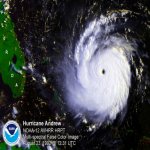
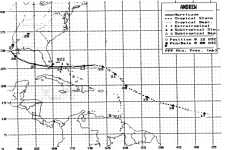
|
Hurricane Andrew
August 23, 1992
Hurricane Andrew was the 3rd category 5 hurricane to hit the U.S. on record. Originally it was classified as a strong category 4. After additional evaluations and research, it was upgraded to a category 5. It caused catastrophic damage to south Florida near Homestead with sustained surface winds of 165 mph at landfall. Andrew made landfall at Elliott Key and shortly after near Homestead, Florida. After spending only a few hours over south Florida, Hurricane Andrew restrengthened in the Gulf of Mexico turned north and made a third landfall in Louisiana as a category 3. Hurricane Andrew at the time was the costliest hurricane on record with 26.5 billion dollars in damage. Andrew also had the fourth lowest pressure of any U.S. hurricane at landfall at 922 millibars. A Hurricane Hunter aircraft measured a 10,000 foot flight level wind of 196 mph just before landfall in south Florida.
Click here for Hurricane Andrew facts and complete summary.
|
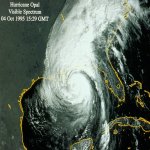
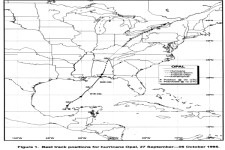
|
Hurricane Opal
October 4, 1995
Hurricane Opal developed into a category 4 hurricane as it moved from the Bay of Campeche to the central Gulf of Mexico.
It went through an eyewall cycle in where the inner eye structure weakened and was replaced by a larger one before landfall.
Because of this, the winds dropped from 150 mph and Hurricane Opal made landfall as a weak category 3 hurricane. Opal made landfall near
Pensacola beach, FL. Hurlburt Field airport measured a gust to 125 mph. Atlanta, GA experienced extensive tree damage with wind
gusts to near hurricane force.
|
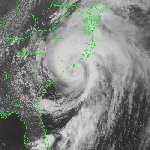
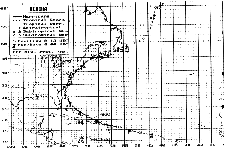
|
Hurricane Bertha
July 12, 1996
Hurricane Bertha was the first of two hurricanes to make landfall in eastern North Carolina within two months. Hurricane Bertha
was at its strongest north of Puerto Rico when it was a minimal category 3 with top sustained winds of 115 mph. By the time Hurricane
Bertha made landfall between Wrightsville and Topsail beaches, N.C. it had weakened to a category 2. Frying Pan Shoals measured a gust to
101 mph and New River a gust to 94 mph. Storm surge damage was not only felt on the coast, but also on many of eastern North Carolina's
rivers.
|
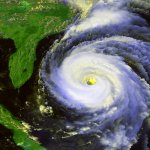
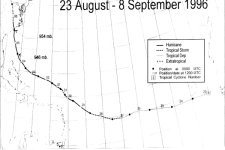
|
Hurricane Fran
September 4, 1996
Hurricane Fran was the second hurricane to hit eastern North Carolina within a two month period. In a similar fashion, Hurricane Fran made
landfall at Cape Fear, North Carolina. This was just south of where Hurricane Bertha made landfall. The top wind gust was reported from a home
anemometer in Wimimgton of 137 mph. Southport had a gust to 91 mph and Atlantic Beach as well as Greenville had gusts to 87 mph. Extensive storm surge flooding
once again occured in eastern North Carolina as a tidal surge pushed well inland. A surge of around 8 feet was seen as far inland as Washington on the Pamlico River.
|
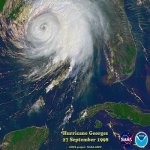
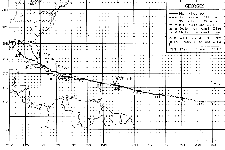
|
Hurricane Georges
September 27, 1998
Hurricane Georges reached its maximum intensity east of the islands as a strong category 4 hurricane with top sustained winds of 155 mph.
It made a total of seven landfalls as it skimmed the Leeward islands then across Puerto Rico, Hispainola, Cuba then to the U.S.
Hurricane Georges made landfall near Biloxi, Mississippi with a top gust of 117 mph. Tidal surge was east of the center where Fort Morgan, AL
had a measured surge just under 12 feet. A wind gust of 130 mph was reported at Fajardo, Puerto Rico and 164 mph at Isabela. Hurricane Georges
also caused flash flooding and mudslides in Haiti and the Dominican Republic which resulted in nearly 600 deaths.
|
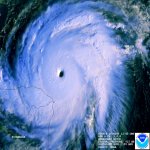
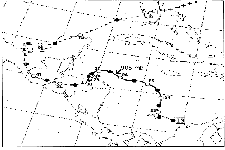
|
Hurricane Mitch
October 26, 1998
Hurricane Mitch will be remembered as a powerful killer hurricane to effect Central America. Over 9000 lives were lost, primarily
in Honduras and Nicaragua where at least 35 inches of rain was estimated. Another 9000+ people were listed as missing. Hurricane Mitch is only
second on the list as the most deadly Atlantic hurricane. The Great Hurricane of 1780 to affect the Lesser Antilles is first. Also, Hurricane Mitch
was the strongest October ever recorded up to that time. Hurricane Wilma would surpass Mitch as the strongest in 2005. Top sustained winds for Hurricane Mitch
were a powerful 180 mph at its strongest east-northeast of Honduras.
|
Hurricane pictures and summaries main page.
|
|
|